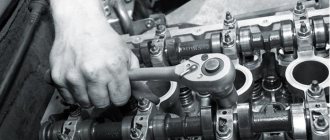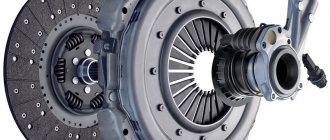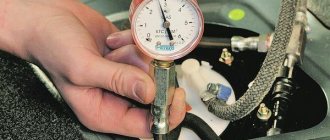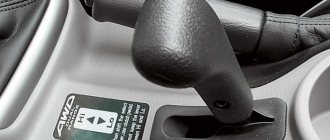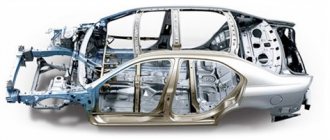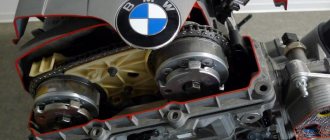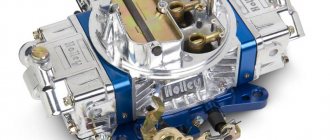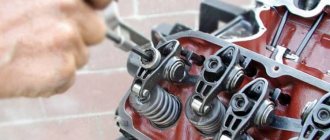The stabilizer link is one of the elements of the car suspension that belongs to the stabilizing system. The main operating mechanism of this system is the anti-roll bar (SST), which is necessary to prevent the car from tipping over and turning over during sudden maneuvers: braking, turning, etc.
Design and purpose of the stabilizer strut
The design of the stabilizer struts is primitive and their typical designs do not differ greatly from each other. The length of the rod, the angle of the hinges and their size, the length of the fingers are different for each car model. Sometimes silent blocks (rubber bushings) are used instead of hinges, and combined designs are also found. There are several types of traction:
- With two hinges (most common);
- With two elastic bushings (silent blocks);
- With one hinge and one bushing.
Let's consider the most popular and complex (compared to other possible) design option - with two hinges. Such “bones” consist of a rod and two hinges in the housings, liners, anthers and a rod. The main working element in the form of a standard hinge (exactly the same design for a ball joint, only larger in size) consists of:
Ball pin; Boot with clamps; Polymer liner; Nuts; Ball housing.
The purpose of the stabilizer bar is the kinematic connection of the anti-roll bar with the shock absorber strut. The stabilizer is fixed to the subframe relatively motionless - the shock absorber strut can rotate both to the right and left (in turns), and up and down (when driving over uneven surfaces). To ensure a movable connection between the stabilizer and the shock absorber strut, the “bones” must have a certain degree of freedom; hinges or rubber bushings serve this purpose. They also fail; we will not consider cases of traction separation - this is not normal and is a manufacturing defect or the consequences of an accident.
Stabilizer link with hinges in section
Almost all modern cars come with a stabilizer, usually the front one. Less often, a rear one is additionally installed. Therefore, it is not difficult to calculate how many stabilizer struts are in the car - two or four .
Reasons for the fragility of stabilizer struts
In some cars, the struts “fly out” after 10,000 - 15,000 km. The main reasons contributing to this are:
- "Soft" metal fingers . Low-quality alloys quickly wear out and begin to play and knock;
- Poor fit of the plastic insert and the “ball” of the finger. If the “fingers” in the new stabilizer link rotate easily by hand, this is a sign of their fragility;
- Poor quality rubber boots . It tends to crack quickly and allow moisture to pass through;
- Weak boot clamps . The Chinese can easily replace metal ones with rubber ones, which are not able to ensure a tight fit of the boot, especially in winter, as a result - hello service;
- Not enough lubrication. We will not mention Chinese spare parts here - this is a problem for most manufacturers; the high price of a part is not a guarantee of quality. A drop of grease is normal (not).
- Difficult operating conditions. Regular driving on gravel roads and roads with potholes is an easy way to ruin the suspension. The “bones” are among the first to suffer.
Anti-roll bar assembly with stabilizer struts
If one of the stabilizer struts fails, it is recommended to replace both at once, because they work in pairs, and if one “dies”, the second one will soon break too.
Design and operation of racks
As a rule, a stand is a rod 5...20 cm long. At both ends there are hinges that provide a movable connection. These can be either two ball joints, or a joint and a stabilizer bushing, or two bushings, or a joint on one side and a thread on the other. They are usually welded to the rod at a right or close angle.
In the place where the tip adjoins the metal rod there is a thinning (“neck”). It serves as a kind of fuse. If the mechanism experiences extreme loads, its body will break in this very place. Otherwise, the strut may break anywhere, breaking through the bottom of the car and causing harm to passengers or other mechanisms.
It is for safety reasons that the racks are not made too thick, which is why they often fail. Although non-original spare parts have a slightly larger diameter, which is a kind of compromise between safety and wear resistance.
Articulating stand device
The most popular currently are racks using a ball joint . Its design consists of two parts - a steel ball pin and a plastic seat with temperature-dynamic lubrication. The finger is pressed onto the top with a plastic or metal cap.
The hinge joints are always protected with sealed boots and lubricant. It ensures smoother operation of the mechanism and also increases its service life. The lubricant is frost-resistant, ensuring normal operation of the vehicle's chassis system in winter.
Sealed boot
To better understand the principle of operation of the rack, you need to remember that it is not rigidly connected to the stabilizer, providing limited movement of the elements combined into the mechanism. When turning a car at speed, its natural roll occurs. In this case, the same forces act on the body, and on the suspension - directed in the opposite direction. If they are not compensated for, there is a risk of breakage of the associated elements - the stabilizer and the hub eye. Thus, the stabilizer link is a damper that receives and dampens large multidirectional forces. However, during operation, under the influence of the mentioned forces, a gradual destruction of the hinge joints occurs. As a result, the racks become unusable.
Some foreign automakers produce adjustable stabilizer bars (for example, the Nissan Patrol GR has an electronically switchable anti-roll bar). There are also SUVs in which the operation of the stabilizer and its struts is controlled by an ECU.
What are bones on a car - What are bones in a car suspension
Surely, while in a car service center, you have heard this expression more than once from car mechanics, like bones.
Our article today will help you and explain what bones are in a car suspension. But We will start from the very beginning. A moving car is subject to centrifugal force when it makes a turn. In this case, the load on the outer wheels increases, and on the inner wheels decreases. To reduce body roll and sway, which can cause a rollover, every vehicle with independent suspension is equipped with an anti-roll bar to help redistribute forces in the suspension.
To connect the ends of the anti-roll bar (STU) to the suspension, stabilizer links, colloquially referred to as “bones,” are used. Now you know that the bones in the car’s suspension are the same stabilizer bars, at the ends of which, to ensure the mobility of the connection with the suspension, hinges are provided.
Installation of stabilizer struts (bones)
By their design, stabilizer struts are a rod with a length of 5-20 centimeters, to the ends of which at a certain angle, most often a little more than 90°, hinged joints are welded, consisting of a cage with a hinge pin and similar to ball joints.
A thread is cut on the hinge pins, which allows you to connect the stabilizer struts (bones) with the rest of the suspension elements using nuts. To protect the strut hinges, sealed boots are used, filled with a special lubricant that maintains quality at low operating temperatures.
Often, when introducing a stabilizer with an enlarged cross-section into the design, the stabilizer struts are made with a single articulated joint and attached to the stabilizer through a conventional composite silent block.
There are two types of racks by design:
• The first type is symmetrical, when the orientation when installing up-down, right-left is completely unimportant;
• The second type is asymmetrical, in this case the hinges at opposite ends of the rack are fixed at angles different from each other, which requires their precise positioning during assembly.
Function of the stabilizer link (bones)
To connect the steering knuckle (front suspension) or hub (rear suspension) to the anti-roll bar, a stabilizer link (bone) is used, thanks to which a connection with limited mobility of the elements is guaranteed.
A similar design solution is used to eliminate the possibility of damage to the hub eyes and the stabilizer itself under the influence of multidirectional forces that arise when the car moves in a turn, which act on the car body and its suspension.
As a result, the stabilizer strut performs a damping function, perceiving loads and absorbing them. The result is gradual wear of the hinge joints with their subsequent destruction.
Stabilizer link - common causes of failure
Due to the constant multidirectional loads experienced by the stabilizer links, these suspension elements usually require replacement more often than others. Often, due to the quality of the road surface, already in the first twenty thousand kilometers, even with the visible integrity of the anthers, signs may arise that require attention to this unit:
• strange knocking sounds coming from the suspension area when driving, especially when overcoming speed bumps;
• “swimming” of the car, its independent departure from a straight path with the need for constant steering;
• when cornering, excessive rolls begin to be observed;
• when the car brakes or moves in a turn, despite the serviceability of the shock absorbers, it begins to sway.
Stabilizer struts - your own diagnostician
Front suspension, in order to diagnose the integrity of the hinges on your own, it is enough to perform a series of sequential actions: turn the wheels to the side as much as possible, use a pry bar to rock the strut from side to side. In the absence of any significant efforts, we can state the imminent demise of the hinges. If you manage to climb with your hand, it is possible that you will even be able to feel their play.
How to change stabilizer links
It’s worth mentioning right away that replacing stabilizer struts will differ for different brands and models of cars. But as a rule, the procedure is not difficult and is accessible even to inexperienced car owners. To do this, you need to have a jack and plumbing tools - wrenches, hexagons, a pry bar (depending on the car model). The front and rear struts are different for most cars. The front ones are long, the back ones are short.
Note! It is recommended to change the stabilizer struts in pairs (right and left at the same time), even if only one of them is knocking.
The first thing you need to remember before starting work on replacing struts is that the axle of the car where the spare part is supposed to be changed must be completely suspended , that is, the stabilizer and strut must be in an unloaded state. This can be achieved by jacking it up on one side, and then installing the ball on the stand. Otherwise, even if you can dismantle the old rack, you will not install the new one correctly. Statistically, this is the main reason for premature rack failure.
, do not damage the anthers under any circumstances . If they are in poor condition, replace them. After all, the service life of the rack directly depends on their integrity.
Remember that after replacing the stabilizer struts, there is NO need to do a wheel alignment check, since they do not affect the wheel alignment.
Replacing the front stabilizer bar on a Ford Focus
Diagnostics and replacement of struts on TOYOTA RAV4 2002
We also advise you to familiarize yourself with the video instructions for replacing struts on Chevrolet Cruze and Renault Logan.
What is a stabilizer bar used for?
To combat these rolls, an anti-roll bar is included in the suspension design. It looks like a bent U-shaped rod made of spring steel. Its ends are connected to the suspension elements, while in the central part it is screwed to the car body.
Its functioning boils down to the fact that when rolls occur, the stabilizer twists, which creates a force counteracting the roll, since the springy steel tends to take its original position when twisted. That is, this suspension element cannot eliminate the occurrence of rolls, it only reduces it.
The stabilizer is applicable only on independent type suspensions. Therefore, on most cars only one stabilizer is used - in the front suspension. This design, for example, is used on all cars of the VAZ family, starting from the VAZ-2101 model. Not so long ago, they began to install a stabilizer in the rear suspension of cars that use an independent type. The rear stabilizer is used on such foreign cars as Ford Focus 2 and higher, Mitsubishi Lancer 9, Nissan Primera, etc.
How to check stabilizer links for malfunction?
When European automakers say that stabilizer struts have a lifespan of up to 100 thousand km, they count these kilometers according to their ideal European autobahns. On our roads, the declared figure can be safely divided by two, and only if you’re lucky. All suspension parts depend on the condition of the roads and driving style, and for us both of these factors are not encouraging yet. In fact, they, like some other suspension parts, turn into one of the most frequently changed elements. So it’s better to find out in advance how the first problems manifest themselves.
An indirect sign that all is not well with the struts is the behavior of the car:
- when cornering, the body rolls more;
- it becomes difficult to drive in a straight line (you have to steer all the time to stay in the lane);
- When driving over obstacles in the wheel area, a knocking sound is heard from one side.
However, given that other suspension faults can give similar “symptoms”, it is better to know in advance how to check whether the problem is really with the struts before going for new ones. You can joke that if a piece of the stabilizer link has fallen out and is lying on the asphalt, it is not advisable to put it back. However, even if they look intact, their hinges or bushings may be worn out and therefore unsuitable for use.
Purely visually, you can only determine the condition of the anthers: if they are torn or stained with grease, most likely the hinges themselves are no longer in order. Considering the enormous loads they experience, the ingress of water or dirt disables them almost immediately.
The main symptom of the problem is hinge play . Due to breakdown or wear, they become loose and begin to make that same unpleasant knock that gets on the driver’s nerves.
You can carry out diagnostics yourself:
- Turn the wheel as far as possible to the side to provide access to the hub and stand;
- Using your hand (or any tool such as a crowbar), strongly shake the stabilizer link. It is impossible to break it in this way; the metal and structure are designed to withstand much greater loads;
- If at the same time they knock or noticeably play, it’s time to change them.
- The second test option is to try to rock the car from side to side. A normal suspension stabilizes the body well, so if you managed to manually rock it, this is already a sign of a problem. In particularly advanced cases, the damaged rack will also tap.
Video on diagnostics and replacement
If it is possible to drive the car into a pit, you can involve an assistant in the diagnosis: one rocks the car, the second listens and looks from below. The play can be heard and even felt if you put your hand on a faulty hinge.
Hinges
In addition to rubber-metal hinges, there are also simply metal ones. These are the same ball joints or tie rod ends that you may have had to deal with replacing. Structurally, the hinge is a ball pin pressed into the body. It can rotate in different planes at small angles, while the junction of the pin and the body is covered with a casing that protects it from dirt.
The resource of the joint is quite large - it depends mainly on the condition of the roads and driving style. The condition of other suspension elements is also influenced: for example, springs and shock absorbers. After all, when they wear out, the movements of the finger become greater, which means that it wears out more.
However, the hinge can fail much faster than usual. A cracked or torn boot no longer provides protection from dirt, so a destructive abrasive gets into the friction pair. It has become a normal practice to inspect the integrity of the boot during repairs: specialists from the Favorit Motors Group of Companies do this every time they carry out maintenance on a car’s suspension.
- Knocks are heard on uneven surfaces.
- A creaking sound is heard when turning the steering wheel.
- The car's behavior on a straight line is unstable.
Types of stabilizer struts
Firstly, the stabilizer struts are divided into front and rear, depending on the axles on which they are located. Stabilizers are not always available on the rear axles of cars, while almost all modern cars are equipped with front stabilizers.
Secondly, a distinction is made between active and passive stabilization systems. If in the case of a passive stabilizer everything is clear (classic all-metal construction with constant rigidity), then in the case of an active stabilizer everything is a little more interesting.
Modern technologies allow you to change the rigidity of stabilization depending on the type of road surface and driving speed (maximum rigidity for cornering at high speeds, medium – on dirt roads, when driving off-road, the stabilizer can be turned off altogether). There are several ways to achieve different hardness:
- the use of hydraulic cylinders instead of racks;
- use of active drive;
- and the use of hydraulic cylinders instead of bushings.
Stabilizer link elements
Design features of the front pillars
Front stabilizer strut Ford Focus 2
A-pillars are available in different types, but they are structurally similar. They are a metal rod from 5 to 25 cm long with fasteners at the ends. On the same “Eight” it is made in the form of a small rod 5 cm long, at the end of which there are eyes with rubber bushings installed in them. One eye, the top one, contains the end of the stabilizer. The second eye, the bottom one, is used to attach the strut to the suspension arm.
Which racks to choose
Now you can buy plastic stabilizer struts. They have less strength, are destroyed if something happens and do not cause harm to other parts and passengers of the car.
Length plays an important role when choosing racks. You should pay attention to the length. You also need to look at the packaging, it says what cars they are suitable for. Stabilizers and struts are interchangeable for models of the same brand, for example, for Ford Focus, Ford Fiesta, Ford Escort, Ford Ka 1995-2001, these parts are interchangeable and fit together .
Rack repair
Many car owners do not recommend repairing the strut, since after restoration it can rarely last for a long time. Despite this, there are many ways to restore the functionality of your knuckles. One method is given below.
- Remove the boot.
- Clean out the old grease and add new one.
- Squeeze the joint in a vice in the direction shown in the photo.
An alternative repair option is given below.
- Remove the boot.
- Rinse with kerosene.
- Tap the body with a core.
A more complex method for repairing a rack is shown below.
- Drill the side of the hinge.
- Insert the grease fitting.
- Fill with lubricant.
If the rod breaks, there are also methods to solve the problem. If you have welding, you can use it to fasten the two ends together. An alternative is to cut threads and use special connectors.
Varieties
There are many stabilizer links. They mainly differ by car make. Each car has its own type of traction.
There are varieties of materials for the manufacture of silent blocks and stabilizer link bushings. There are standard rods, and there are polyurethane stabilizer links. The standard ones are most often made of ordinary rubber, and the second ones are made of polyurethane.
Drivers claim that polyurethane is better than rubber based on the fact that it is designed to last longer. In fact, this is true. An ordinary rubber bushing and silent block last no more than 10 thousand kilometers, while silent blocks and polyurethane bushings do not even show signs of wear. Despite the fact that this material is more expensive, it is still in demand. This happens because it is better to change a part once every 15-20 thousand kilometers than to change 2 or 3 parts in the same period.
Why change stabilizer bushings?
Stabilizer bushing
absorbs vibration from suspension components, thereby making the vehicle ride more smoothly and reducing noise.
The bushing
is an elastic part made of rubber by casting.
Interesting materials:
Who produces the Chevrolet Lacetti, country of origin? Who takes the original European protocol? Who is doing artificial intelligence? Who does the sewerage? Who handles off-street parking? Who fills out a receipt for receiving money? Who knew about Batman's identity? Who called 994? Where does antifreeze go if there is no leak? Where does fat disappear when we lose weight?
Stabilizer malfunctions, their symptoms, condition check
Video: Knocking in the front suspension is the most common cause
But stabilizer struts are additional elements in the suspension, and not of a simple design. Therefore, they are an additional place where malfunctions can occur.
If you look at the VAZ-2108 element, rubber bushings are used in the design. During operation, rubber is exposed to various negative influences, which leads to its “aging” (decreased vibration properties, shrinkage, cracks).
On the same racks where ball joints are used, they are the weak point. Over time, wear appears between the ball pin and the joint body, which causes a gap to form between them.
All these malfunctions have obvious signs:
- The appearance of knocking noises when overcoming bumps on the road;
- Increased car roll when cornering;
- The car “floats” on the road (the car spontaneously pulls to the side).
It is not difficult to check the condition of the stabilizer struts, and it does not matter what design it is. To do this, you only need a mount and an inspection hole. If you check on a VAZ-2108, then it is enough to swing the stabilizer near the rack with a mount. Its significant amplitude of vibrations and knocking indicate severe wear and the need for replacement.
As for checking Focus 2, you need to swing the stand itself. Ease of movement and knocking in the hinges will be a signal of their severe wear. But at the rear of this car you need to swing the stabilizer itself.
Springs
Suspension springs are the parts that are responsible for comfort on bad roads. They take on the main load when the wheels come into contact with potholes. Accordingly, the more compression-extension cycles the springs perform, the more they lose elasticity and the worse they dampen irregularities. It would seem that this is not such a critical malfunction, but weak springs create additional load on shock absorbers, silent blocks and other suspension elements. It is very rare, but spring breakages do occur - most often from overload.
- Ground clearance is noticeably reduced when loaded.
- Frequent “breakdowns” appear when driving over uneven surfaces.
- Strong rolls appear in turns.
We identify all problems ourselves
It has already been said here that the most unreliable, most “fragile” part of the stabilizer is the struts. This is done on purpose so that in the event of an accident, the least damage can be caused. Let's name the main symptom accompanying the breakdown of stabilizer struts or rods. This is a dull knock that occurs when driving over any irregularities, potholes and even small stones. And sometimes the car begins to roll out of the roll worse - conclude that one of the struts has already been torn off. But knocking will be observed in 90% of cases! It can come from both the front and rear suspension.
Let's say there is a bushing in the design of the stabilizer struts (photo 2 in Chapter 2). It will then be more difficult to identify the defect: even if the bushing is destroyed, knocking does not always occur. More often the sound will be muffled, quiet, and generally difficult to hear.
Creaks and crunches, especially when cornering, usually indicate the destruction of the boot. But the defect itself, we repeat once again, is rare. The hinge shown in the photo will begin to deteriorate over time. And the creak should then turn into a grinding sound.
Ball joints inside the struts
Shock absorbers
These elements are designed to dampen vibrations from uneven roads. In the simplest design, the liquid inside the shock absorber passes through a system of holes during its operation, as a result, part of the vibration energy is dissipated in the form of heat.
The most common parts to wear out in shock absorbers are the piston O-rings and valves. Another popular scenario is liquid boiling over. This can occur when driving for a long time in the heat on an uneven road: the oil foams and begins to penetrate through the seals, and the effectiveness of shock absorption is greatly reduced. Visually, a “boiled” shock absorber can be recognized by a layer of dirt adhering to the oil-stained body.
- After passing the bump, the car continues to sway for some time.
- Roll increases when cornering.
- Knocks are heard when driving on uneven roads.

